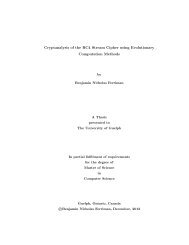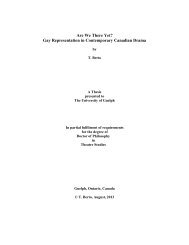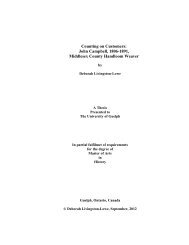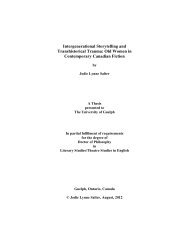THESIS - ROC CH ... - FINAL - resubmission.pdf - University of Guelph
THESIS - ROC CH ... - FINAL - resubmission.pdf - University of Guelph
THESIS - ROC CH ... - FINAL - resubmission.pdf - University of Guelph
Create successful ePaper yourself
Turn your PDF publications into a flip-book with our unique Google optimized e-Paper software.
4.3 METHODS<br />
4.3.1 SAMPLE PREPARATION<br />
The formulation <strong>of</strong> the SPI film contained 100 parts SPI, 70 parts water, and 50 parts<br />
glycerol, by weight. The preparation <strong>of</strong> SPI film was first done by premixing water and glycerol.<br />
The premix solution was added to SPI using a programmable dispensing pump (DP-200, New<br />
Brunswick Scientific Co., INC, Edison, New Jersey, USA) at a controlled rate <strong>of</strong> 6 mL for every 2<br />
seconds. A kitchen mixer (SM-55 Stand Mixer, Cuisinart, Canada) was used to continually mix<br />
the materials during the course <strong>of</strong> solution addition. Mixing speed was set to the maximum and<br />
was left to mix for 15 min. The mixture was equilibrated for 12 hours in a sealed plastic bag prior<br />
to extrusion.<br />
4.3.2 COMPOUNDING AND EXTRUSION<br />
Compounding and extrusion were done using a lab scale extruder, Microtruder RCP-<br />
0625, Randcastle, New Jersey, USA (Figure 4.1a). The extruder features 4 heating zones as<br />
seen in Figure 4.2a. The first three zones are along the barrel with the fourth zone controlling<br />
interchangeable heating cartridges situated inside the strand die (Figure 4.1c) or the lip die<br />
(Figure 4.1b). The slit in the lip die is height adjustable with a maximum gap <strong>of</strong> 0.046 inches.<br />
21

















